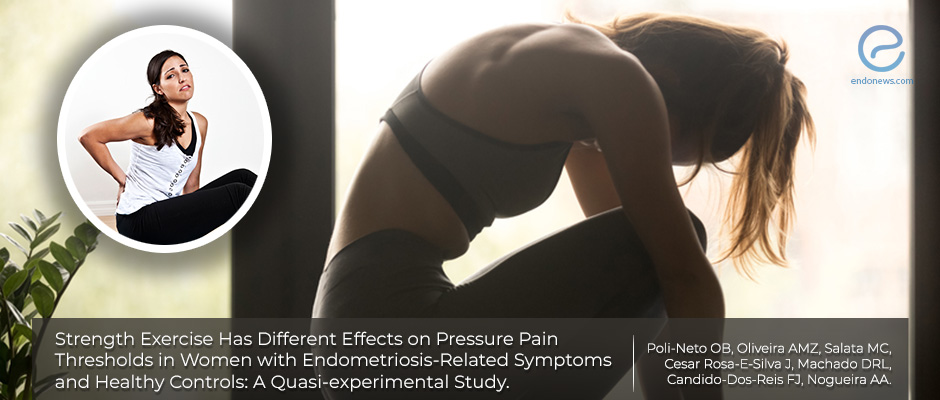Strength exercise may not be helpful for the management of endometriosis-related pain
Feb 12, 2020
Pain thresholds in women with endometriosis do not improve with exercise
Key Points
Highlight:
- Strength exercise can increase pain thresholds in healthy women but does not improve pain thresholds in women with symptoms of endometriosis-related pain.
Importance:
- Pain and pain perception may limit how long women with endometriosis adhere to long term physical training program.
What's done here:
- This study used a quasi-experimental design to evaluate how strength exercises affect remote pain sensitivity in women with endometriosis.
- The study recruited 21 women with endometriosis-related symptoms and 21 healthy women.
- Strength exercise is weekly sessions on an extensor chair for four consecutive weeks.
- Pressure pain thresholds were measured on the nondominant forearm using an electronic algometer.
Data:
- Healthy women had increased pain threshold immediately after exercise, which returned to baseline after 20 minutes.
- Women with endometriosis had lower pain thresholds and were not improved after exercise. There were higher heart rate and systolic, diastolic, and average blood pressure in the endometriosis than the healthy group.
- Pressure pain thresholds did not correlate with heart rate or blood pressure.
Limitation:
- Small sample size.
- Non-randomised quasi experimental design carries confounding bias.
Lay Summary
Women with endometriosis often suffer from pelvic pain, although the disease severity is not correlated with pain intensity. Research in pain symptoms suggests that several neuromodulatory events are involved, including reduced peripheral induced pain thresholds and significant changes to the central nervous system. Interestingly, recent studies also suggested that physical exercise can reduce clinical pain. Reduced sensitivity to pain stimuli can be promoted by aerobic and anaerobic exercises, although it is yet unclear why this is the case. Therefore, physical exercise has the potential to act as a pain killer, on top of other benefits. Hence, it is probably useful to prescribe physical activity for the management of persistent pain in women with endometriosis. Women with endometriosis seem to be less likely to exercise than healthy women. Studies showed that they tend to be more difficult at starting and maintaining an exercise program.
The article by Poli-Neto et al. hypothesized that exercise may be unpleasant to women with endometriosis-related pain symptoms. Thus, the authors evaluated the effect of strength exercise in the remote pain sensitivity of women with endometriosis. The study results were published in "Pain Medicine".
The experiment recruited 21 women with endometriosis-related pain symptoms and 21 healthy women. The study was not randomized and the strength exercise was leg extension strength on an extensor chair weekly for four consecutive weeks. The exercise four series of 15 repetitions in intervals of one to two minutes with a 60% estimated load. All participants were encouraged to give the best performance. Measures include the pressure pain thresholds which were obtained from an electronic algometer on the nondominant forearm, the heart rate and blood pressure. The measurements were taken at various time points, including before, immediately after, 10 minutes and 20 minutes after exercise.
The study results show that strength exercise does not influence the two groups similarly. Overall, women with endometriosis had lower pain thresholds. In healthy women, pressure pain thresholds increased immediately after exercise and returned to baseline after 20 minutes. However, women with endometriosis did not show pressure pain threshold changes after exercise, despite higher heart rate and average blood pressure than healthy women.
This study is limited by the small number of participants and quasi-experimental design, which has an intrinsic confounding bias. The data suggest that women with endometriosis do not show similar pain thresholds respond as healthy women after physical strength exercise. Overall women with endometriosis have a reduced pain threshold that cannot be improved with physical exercise. These findings may explain the hindrances that women with endometriosis experience, which limits their willingness to start and maintain a long-term physical training program.
Research Source: https://www.ncbi.nlm.nih.gov/pubmed/31800061
exercise management

